Technology in Education has evolved from a novelty to a core engine of how students learn, teachers teach, and schools operate. In the modern classroom, a dynamic blend of devices, platforms, and software enables deeper engagement, personalized learning, and scalable collaboration, supported by thoughtful design and robust infrastructure. This evolution is underscored by edtech trends 2025 that emphasize data-informed guidance and scalable supports. The concept of transforming classrooms with technology reflects a shift toward student-centered inquiry and hands-on exploration. Educators, administrators, and families are increasingly focused on leveraging these innovations to build inclusive, future-ready learning experiences for continued growth and societal benefit.
Across schools and districts, the conversation shifts from gadget-heavy hype to thoughtful integration of learning technologies that support pedagogy. Educators describe a digital learning ecosystem where platforms, data, and collaboration tools align with curriculum goals. From smart classroom setups to AI-assisted tutoring, the landscape is about enabling smarter teaching and more personalized, learning experiences. As schools navigate policy, privacy, and support for teachers, the goal is to connect technology with meaningful outcomes—learning growth, collaboration, and critical thinking.
Frequently Asked Questions
How are educational technology tools and digital learning platforms shaping Technology in Education and transforming classrooms with technology?
Educational technology tools and digital learning platforms empower teachers to personalize instruction, streamline assessment, and support collaboration. In transforming classrooms with technology, LMSs organize courses, track progress, and enable real‑time teamwork through video conferencing and cloud collaboration. When used thoughtfully, these tools reduce administrative load and free time for high‑impact, student‑centered learning, while promoting inclusive practices and accessibility.
What are the key edtech trends 2025, and how does AI in education fit into the future of Technology in Education?
Edtech trends 2025 emphasize intelligent, data‑driven personalization and AI in education that scales individualized guidance without replacing teachers. AI in education can provide on‑demand explanations, adaptive practice, and feedback, with human oversight to ensure ethics and privacy. Digital learning platforms enable anytime, anywhere access and competency‑based pathways, helping close achievement gaps when paired with thoughtful design and strong data governance.
| Aspect | Key Points |
|---|---|
| Role and purpose | Technology has evolved from a novelty to a core engine for learning, teaching, and school operations; the modern classroom uses devices, platforms, and software to enable deeper engagement, personalized learning, and scalable collaboration. |
| Core tools and capabilities | Five core capabilities drive modern edtech: content delivery, collaboration, assessment, data-informed decision-making, and accessibility; key tools include LMS, video conferencing, cloud collaboration, and content creation. |
| Content and accessibility | Content creation and accessibility tools enable tailored materials; interactive simulations and multimedia resources support multiple representations; accessibility features such as captions, scalable text, and screen readers widen participation. |
| Trends (edtech 2025) | Trends for 2025 include data-driven personalization, AI-powered tutoring and content generation, and modular digital platforms that support anytime, anywhere learning with equity considerations. |
| Digital platforms ecosystem | Digital learning platforms act as ecosystems that connect learners, teachers, and resources; they integrate assessment, feedback, and social learning while enabling personalized pathways. |
| Classroom transformation | Classroom transformation emphasizes student-centered inquiry, project-based learning, iterative assessments, and portfolios that demonstrate mastery and support ongoing feedback. |
| AI in education | AI in education augments instruction with intelligent tutoring, on-demand explanations, and predictive analytics, while requiring ethics, privacy safeguards, and human-in-the-loop oversight. |
| Implementation considerations | Successful implementation starts with clear goals, involves teachers and students in selection, includes job-embedded professional development, and emphasizes digital readiness and equity in phased rollouts. |
| Challenges and opportunities | Challenges include the digital divide and data privacy; opportunities arise from AR/VR, simulations, and data-driven insights that advance digital citizenship and lifelong learning. |
Summary
Technology in Education is redefining how knowledge is created, shared, and assessed in classrooms worldwide. By harnessing educational technology tools—ranging from learning management systems and video conferencing to AI-powered tutoring and data analytics—schools can deliver personalized, accessible, and engaging learning experiences. This evolution requires thoughtful planning, equity-focused implementation, and continuous professional development to balance human mentorship with scalable digital capabilities. As trends in 2025 and beyond continue to emerge, Technology in Education will empower learners to develop critical thinking, collaboration, and digital citizenship while preparing them for a rapidly changing world.

